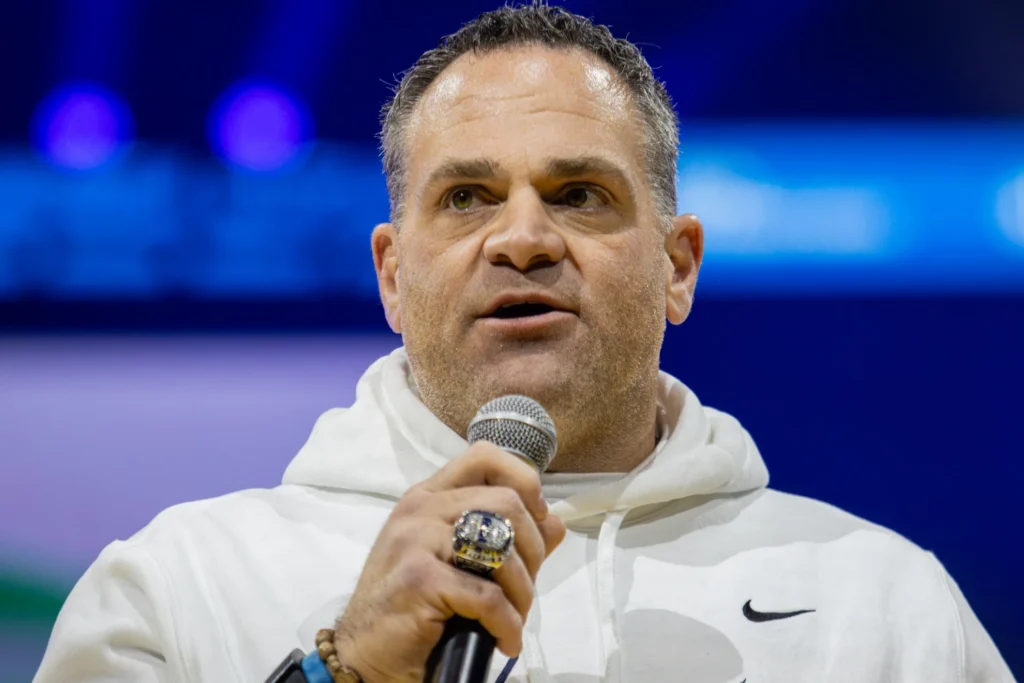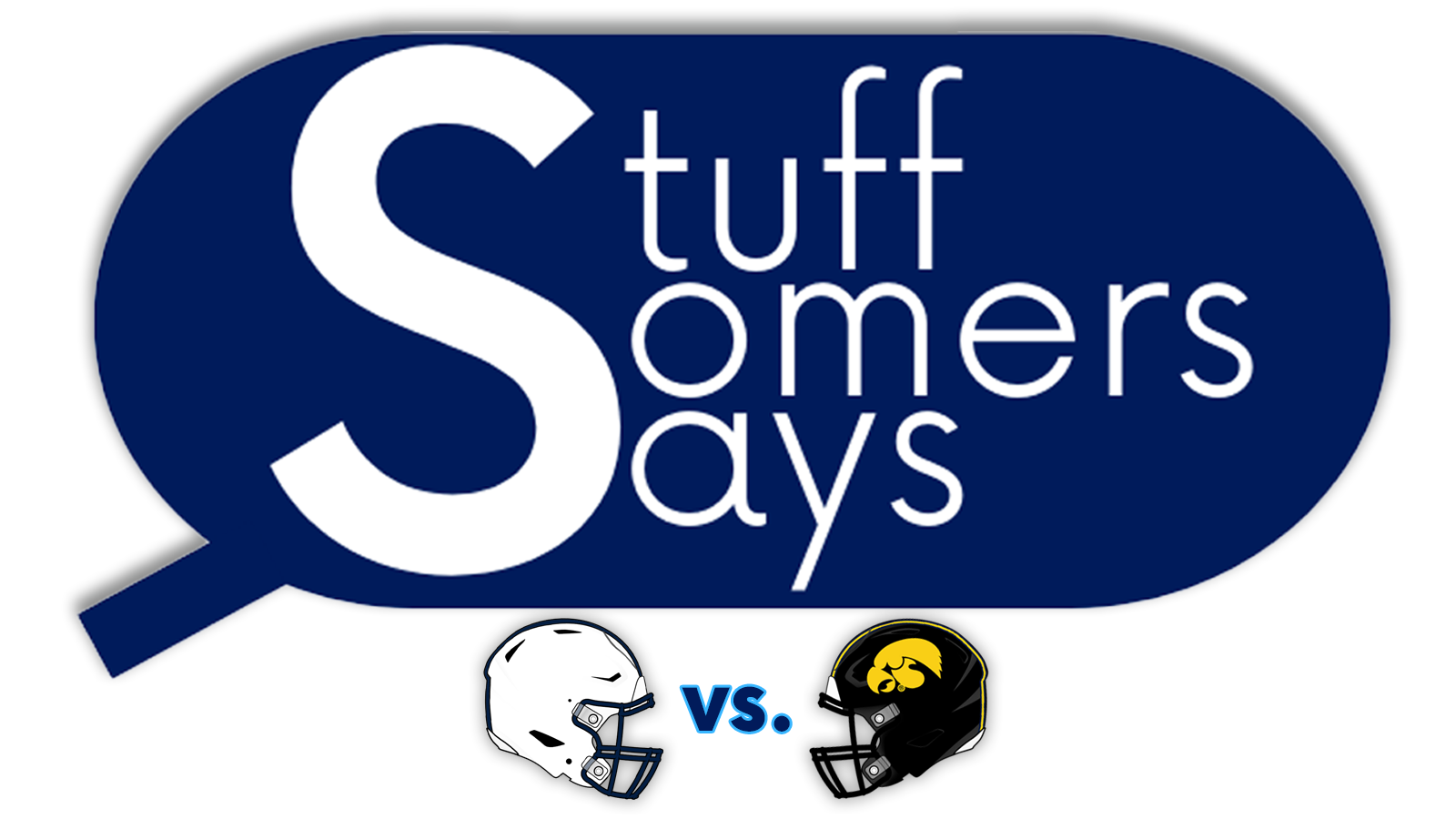
The Pat Kraft era of Penn State athletics isn’t about him being visible on the sidelines. It’s not about him being cheerleader-in-chief, standing as close as possible to the coaching box on the sidelines in what’s become his almost iconic power stance. It’s not about him taking part in celebrations on the mat or ice.
It’s not about him being the most visible administrator in quite some time at Penn State.
Sure those things strike a different tenor than previous Penn State leaders – in a confidently notable way. And while some have postured that he’s building a monster, it’s reasonable to believe he is making one merely stronger.
But that’s because it’s clear now more that the Kraft era is about aggressively challenging – even changing– the status quo.
No finer proof of that can be found than in a $300 million Adidas deal that he helped push through.
The Penn State-Adidas deal, as out of left field as it felt for some, is about Penn State putting Penn State first in the same way Kraft has boisterously fought for his still relatively new employer.
Even as jarring as severing a decades-long relationship, which has soured over recent years, Penn State’s Adidas deal is also a reminder that what was the status quo at Penn State for the better part of the last quarter century no longer is.
“When I got here, I felt like there was no one fighting for anybody,” Kraft recently said in an interview on Roar+. “There was no one fight for Penn State.”
In the first few months of his tenure at Penn State, that was true. Instead, Penn Staters were fighting with each other. In fact, Penn Staters have been fighting with each other for much of the last now-14 years.
Ever since the Jerry Sandusky child sexual abuse case rocked Penn State, there’s been a rift in Nittany Nation – both political and generational divide – that hindered progress while the college sports world spun faster and faster.
The infighting over Joe Paterno’s lasting legacy detracted and arguably distracted from what current Penn State football head coach James Franklin was trying to do. That generational split – between those ready to move on and those lingering to Penn State’s golden era that for those born around the beginnings of Penn State and Nike’s relationship had never seen – was intense.
Even when Penn State pushed through a field-naming rights deal with West Shore Home that needed Board of Trustees approval, the seemingly fleeting, somewhat tired arguments were dusted back up. They, even in classically predictable fashion, trickled into downtown merchandise stores and can be occasionally found at a tailgate or two in the 2025 season.
But a lot of that consternation seemed to be in its dying-ember stage by that point. Since 2022, Kraft’s ability to challenge that status quo has only accelerated the erasure of those pain points.
That status quo was one, which in a similar way Penn State is still actively pursuing a football title, felt stuck in an increasingly bygone era of college athletics. At one point, though, that status quo was exceptional.
Penn State and Nike’s bond in the 1980s and by the time Penn State joined the Big Ten in 1993 – the same year the swoosh was permanently added to the uniforms – felt as strong as Nike’s bond with many other sports titans. Penn State was one of just a handful of schools to outfit all of its football team with Nike cleats – ones that it wore during the 1986 National Championship.
The image of Paterno prowling the sidelines with his pant legs rolled up while donning the same white swoosh on black shoes as his players became a part of the mystique to The Grand Experiment.
That relationship between the school and athletic brand developed so much that Phil Knight named its child care facility after Paterno – all while Penn State alum Mark Parker was CEO of the brand.
When Paterno died in 2012, Knight gave one of the eulogies.
The Penn State story that truly turned Penn State’s athletic department into what it is now can not be written without at least a significant contribution from Nike.
But of course, the Penn State story can not also be written without what happened in the few months prior to Paterno’s passing and what came in the summer after.
The Freeh Report was released. The Paterno name was removed from the Nike building. The sanctions hit. Another Brown alum in Bill O’Brien took over the coaching spot. After having stability for parts of six decades, Penn State lost it when O’Brien bolted for the NFL after two years. Other leadership changes at the athletic department and university president level churned with rapid succession.
For athletics, 2012 until 2022 felt relatively stagnant compared to how much has changed since 2022 — even in spite of all of those changes. If it was a newer era with new faces, coaches, names and literal names on the back of the jersey, it felt like little had improved the status quo. The Sandusky case and the fallout from that held Penn State back as an undertone to all of it. Constant infighting slowed down progress to a point where we now hear Franklin reference the lack of “alignment” he had between the Lasch Building, Old Main and the Bryce Jordan Center’s administrative wing with a twinge of resentment.
During that time, Penn State’s Olympic sports maintained their status quo of winning a national title here and there (except for wrestling which continues to do it repeatedly) – and only in the latter part of the 2010s did the thoughts of a national championship in football seem remotely possible – yet still far off. All while in the background, the Nike relationship soured with increasing intensity.
As Jon Sauber reported in the Centre Daily Times, that bond – and the symbiotic nature of that relationship between Penn State and the iconic Just Do It brand – started to dissipate in the final years of the Sandy Barbour era. In 2020, Parker left Nike. But even prior to that, Penn State received less financial support from Nike compared to Ohio State, which in 2016 inked a deal worth roughly $16.8 million per year. While the exact details of the Nike contract were never made available to the public under Penn State’s status, indications are that the Adidas deal is a significant bump up from what was with Nike.
By the time early rumblings that an Adidas contract was sitting on Neeli Bendapudi’s desk, Penn State had been well overdue for a visible change like this.
Mix in a massive stadium renovation and changing what’s felt like every major contract1 including switching from Learfield to Playfly as media and advertising rights holder, Kraft hasn’t backed down from – as he put it to Lavar Arrington on the school’s shiny new NIL media publishing space – “fighting” for Penn State. The brute force with which he’s attacked Penn State’s athletic program’s situation – while not always the fan-favorite course of action – has effectively closed the chapter on the book of the Penn State we’ve collectively known for the last 30-or-so years.
There is too much change to no longer ignore.
The Adidas deal and $300 million that reportedly comes with it sets a new tone for what is the status quo and puts Penn State in a better position to do more than survive in college athletics’ current NIL-revenue-sharing-need-every-damn-dollar-we-can-get era. It also puts Penn State in a strong financial spot without burdening the fan as much as the insistent asks for a donation here, there and everywhere — even if it may not absolve them of a share of the burden. That 300-million dollar figure effectively equals a year and a change worth of cost it takes to run Penn State’s athletic department.
It – as Kraft alluded to in his interview – above all makes Penn State a priority in the same way he sees Penn State a priority.
Instead of being Nike’s fourth biggest brand at best in the Big Ten (including Nike’s strongest relationship with Oregon), Penn State becomes Adidas’ biggest Big Ten brand. As college football moves closer and closer to two super conferences between the Big Ten and SEC, now Penn State becomes a flag carrier for one of the world’s most popular brands in America’s second most popular sports league.
Even before Penn State’s $700 million Beaver Stadium renovation is complete, the Adidas logo affixed to Penn State’s iconic jerseys will be a literal symbol of Kraft’s ability to challenge and change the status quo.
It will also serve as the three-lined tombstone to the Nike era – as hard as that can be to swallow for some. For as much nostalgia is evoked by seeing the blue and white wearing black shoes with a white check in a pregame pump-up video or the comfort of your favorite Nike crewneck you’ve had since you were a freshman, that’s all that Nike will ever be for Penn State moving forward: Nostalgia.
And even that nostalgia is changing.
Penn State’s current student body moves further and further away from remembering a time when Paterno was head coach. By the end of this decade, parts of two classes of students who were not alive when Paterno coached will roam campus.
That generation will have no recollection and no attachment to a previous era. Instead, their nostalgia is being built right now – by the actions of mostly Kraft and Franklin.
And eventually it will be that generation that buys the tickets to the games, that donates to NIL, that buys the merchandise. That generation will be the one that Kraft and company have to connect with. They will eventually hold what’s most coveted right now in college athletics – the almighty dollar.
With Kraft’s aggressive approach, though, Penn State seems more ready than ever to embrace that challenge in this and that future era.
Now Penn State will be equipped with a new status quo outfitted by Adidas and fueled by Kraft.
If you’ve enjoyed this content, please subscribe to Stuff Somers Says With Steve on YouTube. Or join our newsletter by entering your email below.
1Except for the Pepsi deal, damnit.

